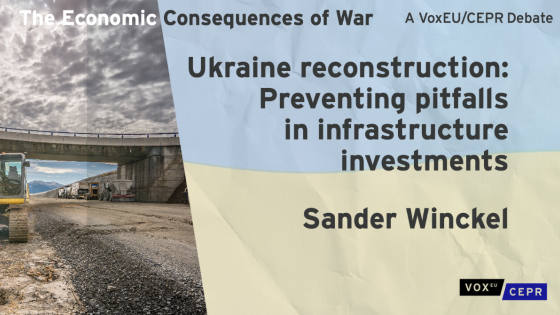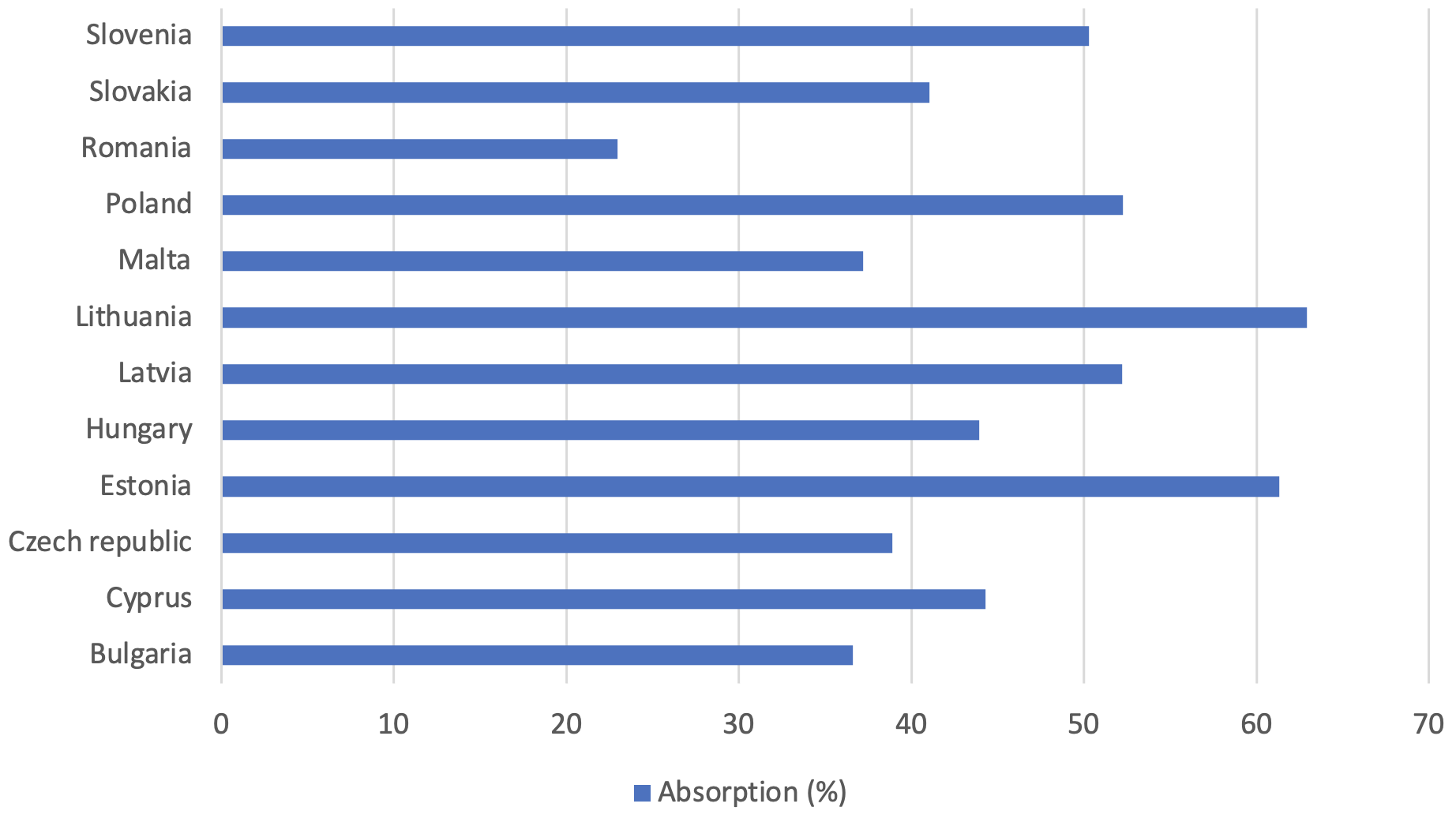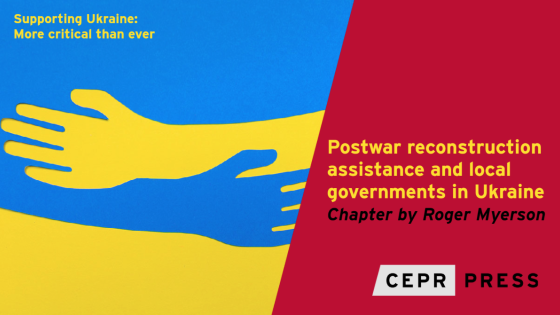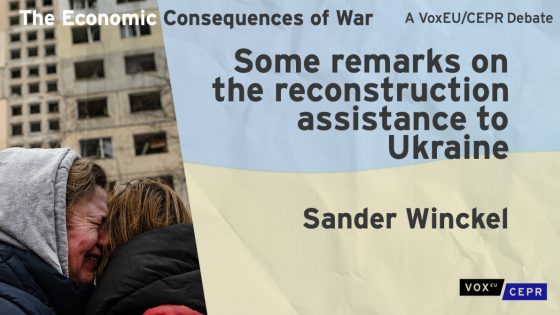The Ukraine Recovery Plan contains many programmes dealing with investments to be made in civil transport, energy, environment, social and housing infrastructure. The investments are key to Ukraine’s planned economic reform and growth. Much attention is being devoted by the parties involved to prepare the technical specifications and the financing of these projects. It is also worth looking at the planning for implementing such projects, in order to minimise delays. The findings of a World Bank review in neighbouring Romania might give useful indications where to focus on.
After its entry into the EU, Romania was absorbing its allocated EU funds (€ 20 billion for 2007–2013), in particular those earmarked for public infrastructure investments, much slower than other new EU members and requested World Bank assistance to review its public investment framework in 2012.
Figure 1 EU funds absorption rate new EU member states, end-2012
Source: European Commission
A World Bank team interviewed three key groups of stakeholders (project proponents, regulatory authorities and the private sector) about projects in the road, environment, and renewable energy sectors. It identified many institutional, managerial, and legal deficiencies, from the overall public investment programme down to project permits.
The Ministry of Finance (MOF) did not assure prioritisation of the public investment portfolio and its alignment with budgetary and technical resources. The existing planning and budgetary processes were not effective and the strategic planning documents of line ministries generally insufficient to guide project prioritization. As a result, the number of projects in the public investment portfolio far exceeded available resources. The MOF was also not in a position to challenge project proposals, nor able to enforce transparency and accountability regarding results achieved. The three-year medium-term expenditure framework did not constitute a sufficient tool for public investment projects. By not capturing longer-term project costs, it was not ensured that funds were set aside to allow for timely completion. Investment programming was not realistic. Large volumes of commitments were pushed back, and the amounts allocated in each of the years were not linked to contractual commitments. There were far too many projects both in the pipeline and ‘under implementation’ compared to the available resources.
The technical capacity of project promoters and regulatory bodies was not sufficient to implement the regulatory framework effectively. Nor did this framework give the incentives and guidance needed (concerning risk management for example) to execute sound projects. These were often postponed until implementation had begun, instead of identified up front. The quality of feasibility studies often was insufficient. This led to delays and cost overruns in project implementation, especially in the transport sector with motorway projects using design-build contracts. Institutional incentives undermined the quality of these studies. Feasibility study work was awarded to consulting firms in an open competitive process, mostly to the firm offering the lowest price, sometimes in combination with the shortest completion time. This focus reduced study quality. Too often, rushed or inadequate feasibility studies led to lengthy delays and wasted resources. The offered price for undertaking a full feasibility study was typically less than 1% of construction cost, compared to a norm of 3–4% in other countries. The terms of reference for consultants undertaking feasibility studies were not always specific enough and sometimes lacked important details.
There was no oversight body or technical advisory group that assured appropriate standards for project feasibility studies, and in most cases no requirement for their independent appraisal. The exception were EU-financed projects over €50 million, where the European Commission and JASPERS
carried out a full appraisal of each project. Such arrangements, which help identify mistakes or gaps in information that are otherwise found by contractors at the tendering stage or in project implementation, were lacking.
Box 1 Consequences of a rushed project
The Romanian government had released a tender to build a road of 25 km, costing €100 million. In order to speed up the construction, the tender period was reduced to 6 weeks, the minimum for contracts under EU rules, but not sufficient for road projects, which require a geological study taking 2 months. As a result, the geological study for this project could not be completed, and on being awarded the tender, the winning company discovered that there was a landslide over 5km of the 25km shortly after starting its activities. The parties ended up in court, fighting over who was responsible for the extra costs, resulting in a substantial delay.
On paper, the regulatory framework was well organised, but some approval requirements did not add value. For example, the requirement for cost-benefit analysis (CBA) of all projects was unnecessary, especially for maintenance related projects such as road rehabilitation. These requirements also heavily challenged the limited review capacity. As a result, CBA was often carried out in a perfunctory manner to comply with regulations and not used to aid decision-making.
Project approvals also became perfunctory due to limited capacity. For example, the inter-ministerial committee charged with reviewing the feasibility studies only checked that the study complied with the regulation. It did not have the mandate or technical competence to question either the content of the study or the economic rationale of the project. While the MOF was part of the committee, it was unable to veto or amend project plans that did not comply with government strategies and priorities, or lacked adequate economic and financial justification. Criteria that should be factors in assessing suitability of a project – such as risk mitigation strategies and project management arrangements – did not figure in the assessment.
In some cases, regulations gave the appearance of managerial control but in practice added little value. One manifestation of this was the widespread use of ‘in principle agreements’, meaning that permit approvals were deferred to later stages of the project cycle. This was particularly common for archaeological and utility permits. Such agreements gave the illusion of accelerating project start-up, but only at the cost of significant and protracted delays during implementation, because information that could be used to inform project design and costing was missing. Primary spending authorities were required to submit to the MOF monthly monitoring reports on implementation of public investment projects, but the reports contained little qualitative information on project and program performance or any remedial actions, and the frequency of reporting was excessive, as compared to practice elsewhere of quarterly or half-yearly monitoring reports.
The general legal framework for permits was reasonably complete, but there was a wide variety of permitting symptoms that affected project implementation. These included poor quality, incomplete and inconsistent information, unexpected and unwarranted conditions, unjustified rejection and unreasonable bureaucratic delays.
Archaeological permits could be a significant obstacle in the road sector. These challenges stemmed from three sources: in the legislation there was no clear, integrated and detailed description of the procedure to be followed by project promoters; capacity constraints among project promoters, and unnecessarily restricting archaeological research to history museums, and consequently, to a closed list of qualified archaeologists.
In the renewable energy sector there were two major problems. The first related to geographical data: the incomplete land register, incomplete mapping of utility networks and the lack of consolidated geographical data at local level.
The second related to inadequate legal provisions, for instance for acquiring land (rights) for transmission lines. Further, beneficiaries and investors complained that the regulation and permits were complex and non-transparent. Renewable energy projects require a permit to connect to the grid, which could only be obtained after payment of a non-reimbursable fee, before a connection contract was signed or financing obtained. There were cases when permits expired before such contract was signed, for instance when the capacity of the grid was meanwhile exhausted, or due to the delays in processing EU-financed projects. The lack of long-term power purchase agreements (PPAs were legally not allowed) was a serious handicap.
The main challenge with environmental permits was the high volume of needless reviews, leading to considerable delays. In addition, the quality of environmental impact assessments was considered uneven and in some cases inadequate. This partially stemmed from a shortage of qualified individuals to carry them out and an insufficient accreditation system.
Finally, the control environment discouraged appropriate risk management, and fear of personal liability for errors contributed to delays in decision-making at all levels. Project promoters and managers seeking guidance on the interpretation of specific regulations often found that regulatory bodies were unable or unwilling to give a definitive opinion that would protect them in the face of an audit. They therefore pursued actions that could be inefficient for the project but reduced their exposure to risk. This was particular the case in procurement decisions, affecting all stages of the project cycle. Many project promoters complained that effective procurement of services was their single biggest challenge in project preparation and implementation.
Conclusion
While the situation of Ukraine’s public investment management (PIM) system might be better than that of Romania ten years ago, there still are substantial deficiencies. Soon, a World Bank TA project to support the Ukrainian Ministry of Economy (which is managing the PIM system) with PIM capacity building will start, but for a limited period of four months only – clearly insufficient to enable Ukraine to contract all envisaged investment projects smoothly. A strengthening of the EU JASPERS programme, which currently only gives support for transport projects to Ukraine, with a dedicated office dealing with all Ukrainian infrastructure projects, located in or near Ukraine, would contribute to a solution for this bottleneck.
References
Ministry of Finance Ukraine (2021), Strategy for Public Finance Management System Reform in 2022-2025
National Recovery Council (2022), Ukraine’s Recovery Plan Blueprint
World Bank (2022), Public Finance Management Support Programme for Ukraine, Capacity building in PIM




